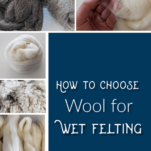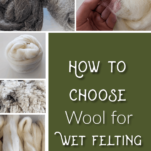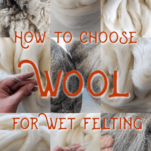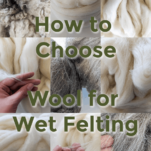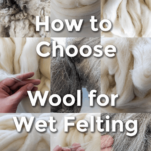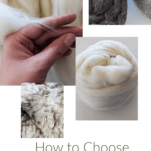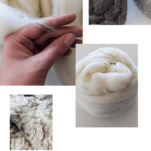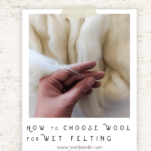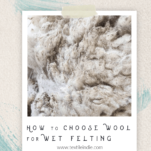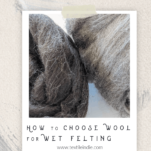This post contains affiliate links. I could be an affiliate for many different products, but I chose these specifically because they are the products and brands I like and recommend. By using my links, you help support this website.
Start with something simple and inexpensive, gradually increasing the quality and investment as you get better and more precise with your projects.
Choosing wool for wet felting depends on the project outcome you are looking for.
Use this fiber guide to help you choose fibers to use for wet felting.
What is your project?
Fiber choice is a key element in wet felting because the type of fiber used will determine the felting process, the outcome of the project, and what the finished felt looks like.
If you are trying to make a hardy piece like a floor rug that will withstand a lot of wear, then use a coarse, dense fiber.
If you are making a scarf or piece that will be worn next to your skin, you want a fine, soft fiber so that it doesn’t chafe your skin.
The first question to ask yourself when choosing a fiber type is what texture you want the finished piece to have – rough and durable or soft and delicate.
Fiber forms
The form in which you use the fiber is the next thing to consider. Do you want to use a raw fiber that hasn’t been washed or a beautifully cleaned roving that neatly lays out in soft tufts?
Rougher pieces that are made for durability (like rugs) can be done with raw fiber or washed uncombed fiber. The finer and more delicate the piece the greater need for clean and well-combed fiber.
Raw fiber
Raw fiber is the hair of a sheep or other fiber bearing animal that has not been washed or combed. It is sheared off the animal and has had no other processing done to it. This is often called “in the grease” because it still has the natural lanolin oils the animal produces.

Washed uncombed fiber
The raw fleece has been washed, but it is still uncombed, so it may still be clumpy and maintain the locks of fiber that it had when freshly cut from the animal. Most of all of the lanolin oil has been washed from the fiber.
Tops or roving
This is the most common way to find processed fiber is at supply stores or online. The fiber has been washed and processed so that it forms a neat and clean rope of fibers that are ready to be hand-spun or felted.

Wool batts
Another form of processing cleaned wool is a wool batt. This looks like a sheet of combed wool that is rolled up and looks like a pillow form.
This is great for creating flat felt because the fibers are already brushed to go in the same direction and the sheets can be separated and then layered in alternating fiber directions to create the flat felt.
What wool for wet felting?
There is a wide variety of fiber-bearing sheep breeds in the world. The variety means you, as the fiber artist, have a vast array of options to choose from.
Each breed of fiber sheep has a distinct fiber profile or collection of characteristics that determine how it will react to different techniques.
These variables include fiber coarseness or fineness, the length of the fiber, and other factors we will discuss below.
Included are a few other animal fibers that are good for wet felting.
Coarse thick wools
I’ve included fibers under the “coarse” category as examples of fibers that are more rough than smooth, not in describing their micron count or another aspect of the fiber, simply in comparison with other options.
Corriedale
Corriedale is one of the finer wools in the ‘coarse wool’ category.
While its texture is crisp and durable, it is still soft. The cream hue takes color well when dyeing and receives natural and chemical dyes.
Corriedale Top from The Woolery

Jacob
This wool comes in a variety of natural colors. Every fleece is different, and getting color consistency is difficult.
It felts well and creates beautiful pieces.
It is often used in its natural colors because of the variegation in tones.

Romney
This fiber has a slightly rough texture; though the fibers are fine, the crimp is loose. The fiber is lustrous and felts into a dense fabric with a slightly fuzzy texture.
Kent Romney Top from The Woolery

Cheviot
The Cheviot breed has a soft, fluffy fiber that is slightly rough in texture.
This fiber sits in the coarser wool category because the fiber ranges from coarse and scratchy to fine and almost smooth.
Because it is often a coarser fiber it is best for items that will not be next to the skin.
This wool takes dyes well, but they come out slightly duller as this fiber does not have much natural luster.
Soft fine wools
Bluefaced Leicester
With a variegated crimp and high luster, this slippery fiber takes some work to felt, but it creates a nice medium-soft felted fabric.
It takes dye well due to the luster of the fiber.
You may see this breed of fiber referred to as ‘BFL’, short for Bluefaced Leicester.
Bluefaced Leicester from The Woolery

Shetland
This fine wool is best for smaller pieces as it is not as durable as some of the coarser wools. It has good bulk and a clear crimp with a slight luster.
Shetland Wool Top from The Woolery

Merino
Merino is commonly available at fiber arts stores and online.
It is a smooth, fine fiber that creates lightweight, smooth products. Great for felting pieces that need to be soft and durable.
Fine Merino Top from The Woolery
Alpaca
This fiber is silkier than many types of wool.
The felting process may take longer with this fiber as you work and agitate it to the felted point you desire.
Alpaca comes in a variety of natural colors, from deep browns and blacks to grays, red browns, heather grays, and others.
The lighter colors can be overdyed if desired.
A handy chart for selecting felting wool:
| Fiber type | Length of fiber | Dyeable? Color characteristics | Fiber texture | Finished felt texture |
|---|---|---|---|---|
| Corriedale | 3-6 inches | Yes. The creamy wool takes color well. | Medium-fine, clear crimp, well-defined locks. | A dense felt with a medium roughness |
| Jacob | 3-7 inches | Varies greatly from one animal to another, Typically on the coarser side. | Yes. Colors are not as clear and brilliant as other wools. | A dense felt with a slightly scratchy surface. |
| Romney | 4-8 inches | Yes. Comes in a variety of natural tones. | Varies, Typically a light coarseness. | Dense felt with a fuzzy texture. |
| Cheviot | 4-5 inches | Yes. Colors not as clear and brilliant as other wools. | Dense, defined crimp. Varying from coarse to almost fine. | A soft, durable felt. |
| Blue Faced Leicester | 3-6 inches | Yes. Clear colors are possible. | Yes. Comes in a variety of natural tones | Highly crimped, lustrous, soft, and durable. |
| Shetland | Wide range depending on location. | Soft and durable felt with a smooth, lustrous texture | Fine with a high durability, Soft crimp | Lighter colors will take the dye. Wide range of natural colors. |
| Merino | 2-5 inches | Whites take color well. | Fine and soft, lightweight, high crimp. | Soft felt that is lightweight. |
| Alpaca | Varies 2-11 inches depending on breed. | Soft, delicate felt, lightweight. | Soft, fine and lightweight. | Soft, fine, and lightweight. |
Fibers to avoid when wet felting
When purchasing fibers online or from a fiber store, read the labeling.
There are wools treated so that the fiber can be spun, knit, and washed without felting.
This is called a “superwash” fiber and will be labeled as such.
This is great news for spinners and knitters because they can make beautiful sweaters and other pieces, and the item won’t accidentally shrink if thrown in the washing machine.
However, for the felter, this is a problem when you want to intentionally cause felt.
Other things to consider when choosing fibers to experiment with is that the shorter the fiber length, the less tendency it has to form a good felt.
There is not enough length in the fiber to cause it to tangle and form the felt desired.
Resources
The Fleece and Fiber Sourcebook: More than 200 Fibers from Animal to Spun Yarn.
By Deborah Robson and Carol Ekarius
One of my favorite places to order fiber online is The Woolery.


